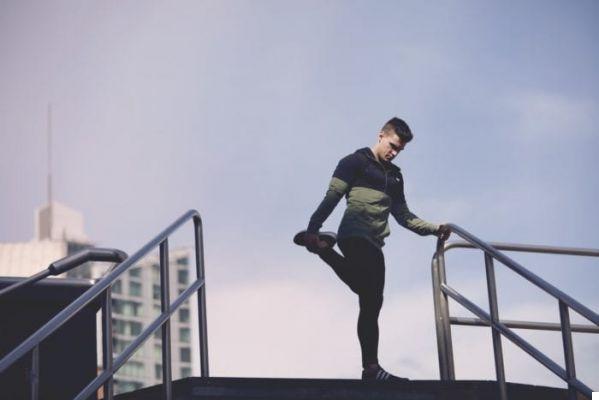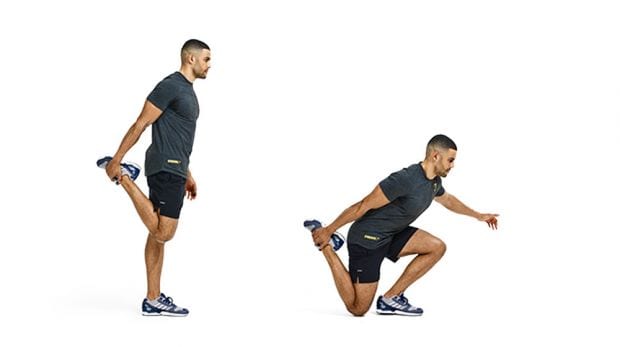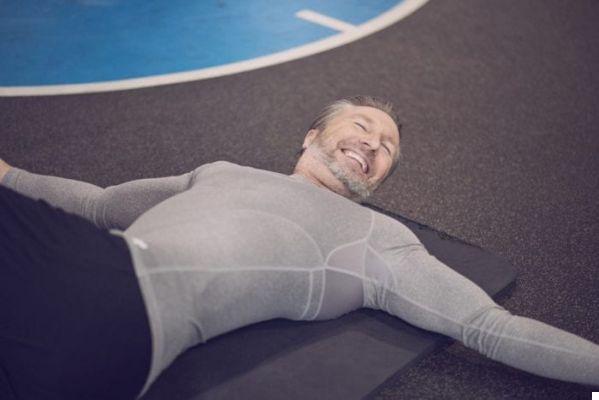A "shrimp squat" refers to a single leg squat exercise. We are therefore talking about a closed and unilateral kinetic chain movement. The support is monopodalic and therefore a good dose of balance and stability is required.
According to the various progressions, mobility also becomes an important factor. A good idea might be consider this exercise as a movement in which to progress in mobility and balance by combining good coordination of the various body segments. Before dedicating yourself to the shrimp squat it is necessary to know how to master deep bodyweight squats, better without the use of shoes, and walking lunges, also in this case without shoes.

How is it done?
Start in a stance with feet close together and slightly extra rotated. From here, grab an ankle with the contralateral hand, flexing the knee as much as possible and bringing one arm behind the back. Before continuing it is necessary to master this position for a few seconds, it makes little sense to load the knee with the weight of the body if you are unable to maintain balance at the start. From this position slowly flex the knee of the supporting leg bringing the torso and free arm forward to maintain balance.
The goal is to make the knee of the unloaded leg touch the ground without losing balance. From here extend the knee and return to the starting position. This is a repeat.

To maintain complete control of the movement it is necessary to use the muscles to carry out this movement. If you try to go from the starting point to the final point of the exercise without muscle control, you end up with the movement hoping for its success but without mastering it.
This lack of mastery leads to great risks on the joints that generally make you stop exercising or lead to injuries. Both cases are not to be prosecuted. The shrimp squat is an exercise that allows you to work on aspects that are often overlooked in the weight room but which are reflected in the
most of the daily movements or in any case prerequisites for more complex exercises.
Muscles involved
The movement can be broken down into a dorsiflexion of the ankle combined with a flexion of the knee combined with a flexion of the hip; all these segments subsequently extend.
The muscles involved are therefore those involved in a normal squat. However, to maintain balance, the knee must move significantly further forward with respect to the foot and therefore the quadriceps are the muscles most recruited in the movement.
Ankle stabilizers also have to work hard. The hamstrings are partially involved, mainly in the deceleration of knee flexion. The buttocks have a significant load due to the pelvis having to move back from the center of gravity.

Common mistakes
The common mistakes of this exercise are attributed to a lack of balance and an inability to recruit the correct muscles. Mobility is an equally limiting factor.
1. Knee valgus
During the eccentric phase, the knee may fall inward with respect to the sagittal plane of the foot. This can happen for two reasons: stenic deficit of the gluteus medius or stenic deficit of the muscles that support the plantar vault (in particular the supinators).
To strengthen the gluteus medius it is useful to maintain the starting position (with ankle gathered behind the pelvis) and concentrate on keeping the pelvis abducted. This should result in a hip pushing the leg into the ground while the torso remains perpendicular to the ground.
This focus should help contract the gluteus medius. To strengthen the plantar arch, you must focus on the support base, always starting from the initial position. From here focus on keeping the first metatarsal, fifth metatarsal and heel in support. The medial part of the foot must remain off the ground forming a sort of arch.
Another expedient can be to push the lateral part of the foot into the ground, this leads to activate the supinators of the sub-talar joint (mainly posterior tibial), often weak muscles.
2. Fall backwards
This occurs due to a lack of dorsiflexion. This may be due to a shortening of the soleus (the gastrocnemius is in tension only with the knee extended) or to a lack of ROM control of the anterior tibialis.
To work on this aspect, the following exercise may be useful: “Starting from the monopodalic position dorsi flex the ankle and flex the knee up to the point where the balance is lost. Stop just before this point and in that position contract the anterior tibial or try to bring the foot upwards. Maintain the contraction for 10 seconds and eventually progress in the movement. In this case you can use a wall as a support to make the exercise more efficient ".
3. Knee flexion too fast
This happens because you are unable to recruit the quadriceps correctly. To work on this, it may be helpful to perform the first few degrees of knee flexion very slowly to the point where you lose control and finish the repetition there. Progressively increase the ROM up to a complete repetition with an eccentric and concentric phase both of 30 seconds.



























